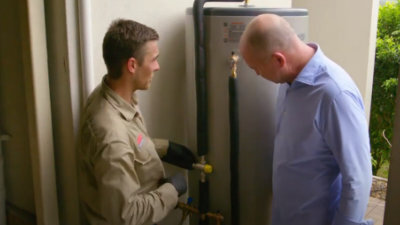16 February 2021
Understanding the function of your hot water valves
From preventing scalding and burns to releasing pressure in the tank; hot water valves can have many different functions. Our plumber Josh explains how each of the hot water valves works on a storage electric hot water system.
In this video we will explain the different valves on your hot water system and what they do.
Understanding the function of your hot water valves – video transcript
[0:03] Mick
So, Josh, hot water system looks fantastic, really quite a treat mate. Really appreciate it.
[0:09] Josh
Thanks, mate.
[0:09] Mick
What are all these valves for?
[0:11] Josh
So basically all these valves and we’ve got a little bit of insulation on these yet, but basically you’ve got your cold water coming through this valve here. This is what we call a Trio Valve, so it’s an isolating, non-return, and pressure-limiting valve.
Firstly isolating means that you can isolate the water simply by turning to the right, just like that, and then turning back on again just like that. So if you ever need to turn the water off to the tank or your hot water in the home it’ll be done by that blue valve.
Non-return, meaning that the hot water cannot escape back through to the cold water line. And pressure limiting, meaning that it limits the pressure incoming to the tank, safe working pressure for the tank and also reducing the risk of damage to your home.
[0:54] Mick
Yeah ok right. Oh so that’s it, does three different things which is great. What about these two? These are pressure-limiting valves too aren’t they?
[1:00] Josh
Exactly, so these are called a pressure relief valve. This one being a cold water expansion valve. They work automatically, so as your tank heats up this will relieve water via the drain line going to the drain there. At the top here, temperature and pressure relief valve. This one relieves pressure out of the tank as it heats up so it builds up steam and relieves via the drain line. But the temperature side of it is a fail-safe so basically if your thermostat in the tank was to fail this would relieve water out of the tank at 99 degrees (Celcius) protecting the tank from overheating.
[1:37] Mick
So it stops exploding.
[1:00] Josh
That’s exactly right.
[1:40] Mick
Okay, okay so we’ve got that, what about this valve through?
[1:43] Josh
So this one’s a tempering valve. Here in Queensland, we have to heat the water inside the tank to above 60 degrees (Celcius) to prevent the growth of bacteria such as legionella. Through the valve comes hot water and cold water to give us a maximum of 50 degrees coming into the home to prevent scalding or burns.
[2:02] Mick
Okay right so the law is that we’re going to be up to sixty degrees so that we actually protect the water and you know get away from those diseases and this to make sure we don’t burn ourselves.
[2:10] Josh
That’s right.
[2:10] Mick
Okay, fantastic. Yeah so is there anything I need to do from a maintenance point of view to make sure that the hot water system that you put in continues to work really well?
[2:18] Josh
Yeah, definitely. Look, there’s a really handy note just at the very top here, above the valve. It explains that you should check the operation of the relief valves at least once every six months.
That’s done by just putting your finger underneath and your thumb on top and just a light pull to make sure that water comes through the drain line to the drain. That means that the valve is in working condition. We also do that on the cold water expansion valve down the bottom. Again so thumb on the top, finger underneath, and a light pull just to relieve that water.
[2:47] Mick
Okay, great so every six months do that just to make sure they are working. Anything else I need to do?
[2:52] Josh
So the tank needs to be serviced. Says here, a major service on the water heater is recommended every six years in the absence of the service in the six years after installation if it contributes to a product failure it may void your warranty.
[3:07] Mick
Right, okay so what does a major service want to do? I don’t want to void the warranty because the warranty is 10 years on these things.
[3:13] Josh
So a 12 year.
[3:14] Mick
12 year, sorry.
[3:15] Josh
Basically, it’s just that we change these two valves and that’s it. The sacrificial anode that I mentioned earlier, we don’t have on this tank because it’s stainless. So it’s just these two valves that we change in the service.
[3:26] Mick
Brilliant, that’s easy mate. Thanks very much, it looks fantastic, really appreciate it.









